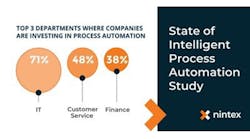Nintex's latest study, "The State of Intelligent Process Automation Study," found a majority of companies (64%) have followed a formal digital transformation plan for three years or less, while one-third of companies have followed a plan for one year or less. Though most companies are in the early digital transformation adoption stages, 94% of decision makers say their transformation efforts are successfully delivering valuable returns on their investments.
Though positive progress on digital transformation goals shows promise, the research reveals a distinct barrier to overall digital transformation success: poor top-down communication.
Only about half (53%) of a line of business employees know what digital transformation is, let alone whether their employer has a plan in place. This issue is most concerning for non-management staff, with 67% of managers aware of their digital transformation efforts compared to only 27% of non-managers. This lack of digital transformation visibility represents a major opportunity for business leaders to better engage and encourage staff.
"It's great to see U.S. businesses making progress on their digital transformation journeys," says Nintex CEO Eric Johnson. "Companies are making significant strides in adopting technologies like intelligent process automation that make all employees more productive. But, there is much room for improvement and growth including better engaging employees in every company's digital transformation plan."
Company decision-makers also see effective communication as an obstacle on their digital transformation journey. Decision-makers cite lack of interdepartmental communication strategies (35%) and insufficient training for a line of business employees on new technology (32%) as challenges that slow digital transformation success.
Johnson continues, "When leaders recognize the role of employees in digital transformation and involve them in planning and implementation stages, they gain advocates and the ability to truly transform both the customer experience and employee experience."
IT Leaders See Promise in Automation Despite Concerns of Job Security
IT decision-makers as a group see more digital transformation potential than any other department, with 71% of them currently deploying process automation technologies. The IT department at large is on the same page, with 94% of savvy IT workers wanting more involvement with their companies' digital transformation efforts.
The IT department's knowledge of intelligent technologies also makes them more concerned about how this technology may impact their career. IT workers rated concern for losing their jobs due to digital transformation efforts higher than other departments, with 39% somewhat concerned and 21% significantly concerned for their job security.
Lack of Clear Transformation Leadership With Accountable Communication Slows Progress
Among decision-makers, lack of transformation leadership is the third most-cited reason why digital transformation efforts fall short of desired success. While the majority of organizations have designated an overall transformation leader, there is lacking consensus over who should be accountable for digital transformation efforts within specific lines of business and departments.
The data shows the disparity in who is leading digital transformation efforts:
- 40% CEO
- 40% CIO/CTO
- 37% Chief Digital Officer
- 22% Chief Customer Experience Officer
- 14% CMO
"Digital transformation streamlines business operations, which generates excitement from employees and leaders alike. But, inconsistent communication of an organization's digital goals and lack of clarity on employee roles in that journey can lead to confusion and disillusionment," says Nintex Chief Evangelist Ryan Duguid.
"Organizations thrive when they designate clear digital transformation leaders to drive cross-team collaboration and educate employees on how new technologies will improve their daily activities and long-term career paths. Both are critical to helping everyone be better positioned to automate, orchestrate and optimize their internal processes and succeed in digital transformation."
The Nintex State of IPA Study findings are based on survey data from more than 450 decision-makers and 650 line of business employees at U.S.-based companies with more than 250 employees. The complete findings are available below.
Study Methodology
Nintex commissioned a third-party research firm, Lucid, in April and May of 2018 to conduct two surveys. The first was completed by more than 450 U.S. decision-makers directly involved in their organization's digital transformation strategies at companies with 250+ employees and work in either manufacturing, healthcare or finance in an operations, IT or marketing role.
The second surveyed 650 U.S. line of business employees at U.S. companies with 250+ employees.










